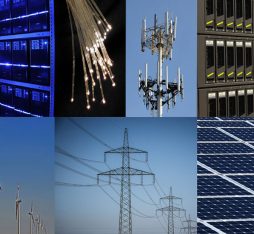Consumers already have access to tools to help them estimate the environmental impact of their digital consumption. Individual customers can get an idea of their cell phone’s environmental impact thanks to a digital carbon footprint calculator available on Orange applications or through the Eco Rating scoring system when they purchase a smartphone.
Measuring the carbon footprint of a product over its entire life cycle, from manufacturing, through usage and to the end of its life.
Calculating the Footprint of a Whole Pool
An increasing number of companies want to estimate their business’s carbon footprint across the entire value chain, either voluntarily or to meet compliance targets. This is a complicated task, as it involves identifying and calculating indirect emissions that are produced by suppliers’ services, such as those provided by Orange. “Designed by Innovation teams, MCO2 is available to sales teams as a tool to help meet the needs of Business customers wanting to know the carbon footprint of their Orange products and services,” explains Christel Fauché, Senior Product Manager, Customer Needs. “This is calculated in a specific way based on the number of lines a customer has installed, as well as the technology used (Fiber or ASDL), the number of cell phones, the type of routers, and so on. In the future, MCO2 aims to expand the calculation to include the complete product life cycle, spanning from the extraction of raw materials, its manufacture and usage, all the way to the end of its life.”
Equipment, Networks and Services
MCO2’s proposed method of calculating carbon footprints is based around the emissions from three areas: customer equipment, networks and services. In terms of equipment, the tool currently focuses on routers in use. Once manufacturers have concluded their work analyzing the life cycle of their products, it will take into account the environmental footprint of the manufacture process. For the networks component, the teams used data validated by Orange with the consulting firm Carbone 4, including data on both manufacturing and infrastructure operations. “Internal network experts have also shared their know-how on determining ways of allocating the carbon impact,” says Maria-José Presso, Developer. “The goal is to define allocation criteria based on a comprehensive model of the whole network’s energy consumption so that it can be distributed according to customer usage. One common calculation method is allocation per volume of data transferred: we know the CO2 equivalent produced for each GB.” We have enhanced this calculation to take into account how the data is actually consumed.
Data Drives the Calculation
Technically speaking, MCO2 is a relatively simple tool which is primarily data driven. “The solution brings together many sources of reference data,” says Guillaume Boudry, Carbon Footprint Expert. This includes data on the energy consumed by a GB (gigabyte) on a copper network for the network component of the calculation, taken from an internal expert study, data from manufacturers or studies to determine the consumption and footprint of the equipment (routers in this case), and so on. The modeling work takes place using models selected based on their international recognition or their ability to adapt to our field of interest.” The technical aspects of the MCO2 project are the epitome of its design specifications, ensuring it is easy to use and meets transparency requirements. The aim is to provide clear information about the assumptions made, reliability and age of the reference data, and the calculation method used, etc. Close attention is also paid to the development of the MCO2 tool to minimize its environmental impact, meaning only developing what is necessary so as to limit the power used by the server where the tool is hosted and to limit data transfer.
Increasing the Scope
This first version of MCO2 will be developed further in the coming months, with several goals in mind. In particular, the tool is expected to be offered to Orange’s Marketing teams in order to assess and optimize the carbon footprint of products and services during their development cycle. It should also be expanded so that the calculation includes more equipment, platforms and services, using an end-to-end approach by including the manufacturing and end-of-life stages.






